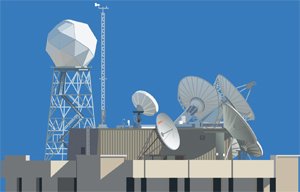 |
Director's NoteHank Revercomb |
GIFTS could “take the world by STORM”
This month, I want to engage you in thinking about an exciting new opportunity for SSEC.
Many of you will remember the advanced GEO sounding instrument named the Geosynchronous Imaging Fourier Transform Spectrometer (GIFTS) that we worked on from 1999 to 2006. The goal was to make earlier warnings of severe storms a reality in the first decade of the new millennium. Unfortunately NASA, and subsequently NOAA (under the GOES-R HES program), pulled the plug on this endeavor, in spite of the success of its technical development and its huge potential benefit to society. The GIFTS-like sensitivity to atmospheric stability for rapidly changing events is needed to fulfill NOAA’s responsibility for severe storm monitoring from space that cannot be achieved with the imaging and lightning detection planned for GOES-R or with any other anticipated technology.
The underlying problem for this and other key programs is the huge price tags that have become associated with new research and operational systems, especially in light of the current economy. Although the benefits would still significantly exceed the costs, the outrageous growth of budgets for new systems that expanded under NPOESS and continued with GOES-R has severely limited US initiatives and is causing us to fall behind the rest of the world. Somehow this cost growth needs to change.
A commercial venture by a new company known as GeoMetWatch may have the answer for procuring some of the spaceborne capability that would benefit the nation and the world at a reasonable cost. The idea for implementing the proven GIFTS capability is to proceed with private funding and to sell the data to governmental and commercial entities. The incentives of this approach are right for curtailing costs, because investors receive no payoff until a system is successfully in orbit collecting quality data--taking longer and costing more do not increase profits.
In the interest of risk-reduction, a major tenet of the GeoMetWatch approach is to make use of the original GIFTS development teams, with Utah State University, Space Dynamics Laboratory leading the instrument development and UW-SSEC leading the data center and processing development. In consideration of such a partnership, we have had in-depth discussions with the principals of GeoMetWatch about how this might work. Based on these discussions, I am convinced that the Center can enter into this endeavor without jeopardizing the nature of our work environment or our commitment to open dissemination of our research products. We would plan to conduct this project in the same general manner as that for any other large project in the Center. However, working as part of such a major commercial venture would be new for the Center, and we will all need to help anticipate and avoid possible problems. One area of concern is possible restricted data availability. It is our understanding that every effort will be made in contracting for data sales to assure that poorer countries have access to key information that would save lives.
In 2010, GeoMetWatch obtained a licensing agreement from the Department of Commerce to place GIFTS-like instruments in 6 geostationary satellite slots around the world (see SSEC 2010 State of the Center, scroll down to page 4). The new instruments for this constellation will be called STORM, so this grand plan explains the title of this Director’s Note. If fully successful, the result will be early pinpointing of the conditions for severe storm development all around the globe (using the rapidly sampled, high vertical resolution profiles of temperature and water vapor from STORM). This success would be talked about the world over.
Based on this vision, SSEC has entered into a legally binding Exclusivity Agreement with GeoMetWatch. Under this agreement, SSEC would be the preferred provider for their contract work related to
- developing algorithms and operational software;
- developing, operating, and maintaining data center systems for the collection, visualization, distribution, and archiving of atmospheric and weather data associated with initial and future hyperspectral sounding instruments relating to the Project;
- providing system engineering, flight hardware (onboard calibration system), testing, and calibration/verification to the Project. In return, we have agreed not to offer these services to any potential commercial competitor for such an advanced sounder venture.
I view this as a very exciting opportunity for SSEC, an opportunity to make a real advance in meteorological remote sensing for the benefit of mankind, and an opportunity to diversify SSEC funding mechanisms to help make our future more secure. Certainly, our experience with the launch and renaming of Suomi NPP have made the last 7 months very rewarding, and when this GeoMetWatch venture takes off, we will be able to put another similar event on our calendars, maybe as soon as 2016.
Over the last year, GeoMetWatch teaming and fund raising efforts have made rapid progress (with key contributions from our own Allen Huang), leading to predictions from some players that a startup could occur in the next 6 months.

